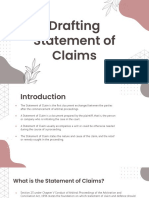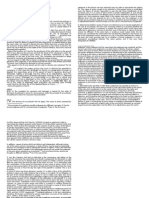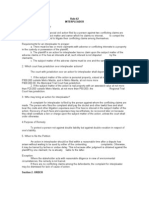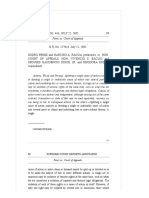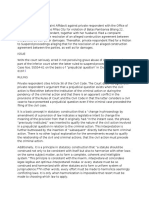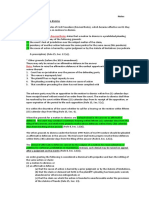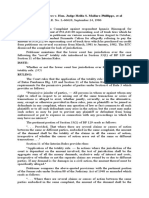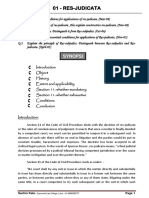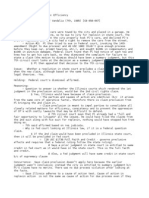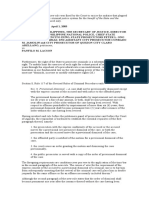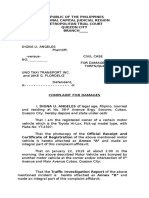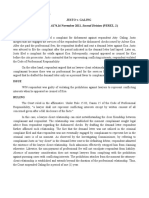Motion To Dismiss Explained
Motion To Dismiss Explained
Uploaded by
IlanieMalinisCopyright:
Available Formats
Motion To Dismiss Explained
Motion To Dismiss Explained
Uploaded by
IlanieMalinisOriginal Description:
Original Title
Copyright
Available Formats
Share this document
Did you find this document useful?
Is this content inappropriate?
Copyright:
Available Formats
Motion To Dismiss Explained
Motion To Dismiss Explained
Uploaded by
IlanieMalinisCopyright:
Available Formats
o res judicata or prescription (statute of limitations)
- not waivable
Q: Distinguish res judicata from litis pendentia.
A: Although the two are related in that they both contemplate two or more actions filed
by the same parties on the basis of the same action, the difference is that in res
judicata, one of the suits has already been settled. Adjudication in one suit bars the
filing of another suit with identical parties and based on identical causes of action.
88
Res judicata:
According to the doctrine of res judicata, it was highlighted “a final judgment or decree on the
merits by a court of competent jurisdiction is conclusive of the rights of the parties or their privies
in all later suits on all points and matters determined in the former suit.”
The elements for res judicata to apply were found as follows:
(a) the former judgment was final;
(b) the court that rendered it had jurisdiction over the subject matter of the parties;
(c) the judgment was based on the merits;
and (d) between the first and the second actions, there was an identity of parties, subject matters,
and causes of action.
Further, it was highlighted res judicata embraces two concepts:
(1) bar by prior judgment and
(2) conclusiveness of judgment.
Bar by prior judgment exists "when, as between the first case where the judgment was rendered
and the second case that is sought to be barred, there is identity of parties, subject matter, and
causes of action."
On the other hand, the concept of conclusiveness of judgment finds application "when a fact or
question has been squarely put in issue, judicially passed upon, and adjudged in a former suit by
a court of competent jurisdiction." This principle only needs identity of parties and issues to
apply.
Prescription:
Article 1146 of the Civil Code states the time when an injured party may claim damages due to a quasi-delict.
It says:
“The following actions must be instituted within four years:
(1) Upon an injury to the rights of the plaintiff;
(2) Upon a quasi-delict;
xxx”
In order for you to file a claim for damages in court, you should have filed your case within four (4) years
after the accident. It appears that since you failed to file any action to claim for damages on the accident that
occurred twenty three (23) years ago, your action has already prescribed. This means that you cannot file any
action for damages against the bus company anymore.
Prescription:
o res judicata or prescription (statute of limitations)
- not waivable
Q: Distinguish res judicata from litis pendentia.
A: Although the two are related in that they both contemplate two or more actions filed by the
same parties on the basis of the same action, the difference is that in res judicata, one of the suits
has already been settled. Adjudication in one suit bars the filing of another suit with identical
parties and based on identical causes of action.
88
Cause of action
A common example of failure to state a claim is in a personal injury claim based on negligence.
For instance, negligence requires that the defendant breached their duty of care to the plaintiff. If
the defendant did not actually owe a duty of care to the plaintiff, then the court might find a failure
to state a claim and immediately dismiss the case.
An example of this is where the plaintiff tries to sue the defendant for failing to help them repair
their car, where the defendant was under no contractual obligation to do so.
In cases where the failure to state a claim is based on a technical aspect, the court will sometimes
allow the plaintiff to amend their complaint, rather than dismiss the claim altogether.
Failure to state a cause of action refers to the insufficiency of the pleading, and is a ground for
dismissal under Rule 16 of the Rules of Court. On the other hand, lack of cause action refers to a
situation where the evidence does not prove the cause of action alleged in the pleading. x x x If
the allegations of the complaint do not aver the concurrence of the elements of cause of action,
the complaint becomes vulnerable to a motion to dismiss on the ground of failure to state a cause
of action. Evidently, it is not the lack or absence of a cause of action that is a ground for the
dismissal of the complaint but the fact that the complaint states no cause of action. Failure to
state a cause of action may be raised at the earliest stages of an action through a motion to
dismiss, but lack of cause of action may be raised at any time after the questions of fact have
been resolved on the basis of the stipulations, admissions, or evidence presented (MACASLANG
VS. ZAMORA [2011]).
Ex:
e the ultimate facts or the essential facts constituting the plaintiff’s cause of action. A fact is
essential if they cannot be stricken out without leaving the statement of the cause of action
inadequate.33 Since the inquiry is into the sufficiency, not the veracity, of the material allegations,
it follows that the analysis should be confined to the four corners of the complaint, and no other. 34
A judicious examination of petitioner’s Amended Complaint readily shows its failure to sufficiently
state a cause of action. Contrary to the findings of the CA, the allegations therein do not proffer
ultimate facts which would warrant an action for nullification of the sale and recovery of the
properties in controversy, hence,rendering the same dismissible.
**
o payment, waiver, abandonment, or extinguishment
o statute of frauds
- ART. 1403, N.C.C.
o non-compliance with a condition precedent
- e.g. failure to exhaust administrative remedies, or failure to undergo barangay conciliation
XX
It likewise bears stressing that a demurrer to evidence under Rule 33 is in the nature of a motion to
dismiss on the ground of insufficiency of evidence and is presented after the plaintiff rests its case. It
thus differs from a motion to dismiss under Rule 16 which is grounded on preliminary objections and
is presented at the outset of the case, that is, before a responsive pleading is filed by the movant and
within the period for the filing thereof.cralaw
77
You might also like
- Excellent Quality Apparel V Visayan SuretyDocument3 pagesExcellent Quality Apparel V Visayan SuretyjpegNo ratings yet
- (Case Digest) Cayetano Vs Monsod (1991)Document2 pages(Case Digest) Cayetano Vs Monsod (1991)Jomelnelyna93% (15)
- in Re Amado MacasaetDocument2 pagesin Re Amado MacasaetVanityHughNo ratings yet
- Drafting Statement of Claims-1Document13 pagesDrafting Statement of Claims-1B-40-Tejal NagmotiNo ratings yet
- Falsification PrescriptionDocument2 pagesFalsification PrescriptionIlanieMalinis100% (1)
- Writ Petition (Nunes Ballot Designation) (00353904xAEB03)Document12 pagesWrit Petition (Nunes Ballot Designation) (00353904xAEB03)hasenrNo ratings yet
- Remedial Law Case Digest - 2020Document70 pagesRemedial Law Case Digest - 2020ShielaNo ratings yet
- CPC - Unit - II NotesDocument52 pagesCPC - Unit - II Notesamullyanagaraj19No ratings yet
- Boston Equity Resources, Inc. v. CA, G.R. No. 173946, June 19, 2013Document4 pagesBoston Equity Resources, Inc. v. CA, G.R. No. 173946, June 19, 2013PASAY cityjailmdNo ratings yet
- CAUSE OF ACTION: ElementsDocument9 pagesCAUSE OF ACTION: ElementsSj EclipseNo ratings yet
- Pacana-Contreras vs. Rovila Water SupplyDocument7 pagesPacana-Contreras vs. Rovila Water SupplyaudreyracelaNo ratings yet
- Rem2. Reviewer Special Proceedings. Rule 72Document18 pagesRem2. Reviewer Special Proceedings. Rule 72Eller-Jed Manalac MendozaNo ratings yet
- Civil Procedure DigestsDocument5 pagesCivil Procedure DigestsJozele DalupangNo ratings yet
- ZAMORA (2011) ) .: Determined in The Former SuitDocument2 pagesZAMORA (2011) ) .: Determined in The Former SuitAndiel KyxzNo ratings yet
- La Naval Drug V CA DigestDocument10 pagesLa Naval Drug V CA DigestIvan Montealegre ConchasNo ratings yet
- Is Res Judicata An Evolving Principle?: Mohammed Anas RiyazDocument15 pagesIs Res Judicata An Evolving Principle?: Mohammed Anas RiyazAastha Dua100% (1)
- Perez v. Court of Appeals, G.R. No. 157616, (July 22, 2005)Document19 pagesPerez v. Court of Appeals, G.R. No. 157616, (July 22, 2005)rafaeligdanesNo ratings yet
- Nabus Vs CA (Mariano Lim)Document2 pagesNabus Vs CA (Mariano Lim)cmv mendozaNo ratings yet
- ReportDocument8 pagesReportStrawber RyNo ratings yet
- Special Civil Actions: Rule 62 - Interpleader: What Is An Interpleader?Document7 pagesSpecial Civil Actions: Rule 62 - Interpleader: What Is An Interpleader?Marco CervantesNo ratings yet
- CivproDocument70 pagesCivproJENNY BUTACANNo ratings yet
- Rule 9 Rem RevDocument9 pagesRule 9 Rem Revjolina cumpioNo ratings yet
- Special Civil ActionsDocument23 pagesSpecial Civil ActionsbubblingbrookNo ratings yet
- Parañaque Kings Enterprises, Inc. vs. Court of Appeals 268 SCRA 727, February 26, 1997Document9 pagesParañaque Kings Enterprises, Inc. vs. Court of Appeals 268 SCRA 727, February 26, 1997CassieNo ratings yet
- Provrem CasesDocument29 pagesProvrem CasesXyra BaldiviaNo ratings yet
- Special ProceedingsDocument46 pagesSpecial ProceedingsKristine Jean Santiago BacalaNo ratings yet
- Perez vs. Court of Appeals, 464 SCRA 89, July 22, 2005Document24 pagesPerez vs. Court of Appeals, 464 SCRA 89, July 22, 2005TNVTRL100% (1)
- SCA Doctrines DigestDocument72 pagesSCA Doctrines DigestAndrea KatipunanNo ratings yet
- Remrev1 Midterms Reviewer TipsDocument24 pagesRemrev1 Midterms Reviewer TipsJohn Henry ValenciaNo ratings yet
- Leges Legibus Est Optimus Interpretandi Modus or Every Statute Must Be SoDocument4 pagesLeges Legibus Est Optimus Interpretandi Modus or Every Statute Must Be SoCofeelovesIronman JavierNo ratings yet
- CIVPROC Finals Reviewer - 25 CasesDocument10 pagesCIVPROC Finals Reviewer - 25 CasesPaul SarangayaNo ratings yet
- 3s Civpro Doctrines-1Document21 pages3s Civpro Doctrines-1MK CCNo ratings yet
- Civ Pro 2Document101 pagesCiv Pro 2Eduard Doron FloresNo ratings yet
- Notes Civpro MidtermDocument8 pagesNotes Civpro MidtermLyrics DistrictNo ratings yet
- Jose v. Javellana, G.R. No. 158239, January 25, 2012Document3 pagesJose v. Javellana, G.R. No. 158239, January 25, 2012Allyza RamirezNo ratings yet
- CPC Project BodyDocument30 pagesCPC Project BodyVishesh Arora0% (1)
- MT NotesDocument22 pagesMT NotesLuis de leonNo ratings yet
- Special Civil ActionsDocument34 pagesSpecial Civil ActionsLuis de leonNo ratings yet
- Concepts and Modes of Discovery - CivProSat1-6 - (AY18-19) - PASTOR, GEE, ADocument10 pagesConcepts and Modes of Discovery - CivProSat1-6 - (AY18-19) - PASTOR, GEE, AmarvinceledioNo ratings yet
- 58 - Flores V Mallare-PhillipsDocument3 pages58 - Flores V Mallare-PhillipsKriselNo ratings yet
- Figueroa v. PeopleDocument9 pagesFigueroa v. PeopleMer CeeNo ratings yet
- General Principles Calo vs. Roldan (G.R. No. L-252)Document6 pagesGeneral Principles Calo vs. Roldan (G.R. No. L-252)EulaArias JuanPabloNo ratings yet
- Provrem and ScaDocument629 pagesProvrem and Scajake tylerNo ratings yet
- Notes On ScarpDocument6 pagesNotes On ScarpalicorpanaoNo ratings yet
- Notes Ligtas v. PeopleDocument44 pagesNotes Ligtas v. PeopleBenedicto PintorNo ratings yet
- Civpro RevDocument102 pagesCivpro RevJocelyn Baliwag-Alicmas Banganan BayubayNo ratings yet
- Cause of Action - Definition & Elements - Failure To State A CA - Test - If You Admit The Truth Allege ...Document2 pagesCause of Action - Definition & Elements - Failure To State A CA - Test - If You Admit The Truth Allege ...ashleysavetNo ratings yet
- Res Judicata: Arman 2010/B.A.LL.B/012Document7 pagesRes Judicata: Arman 2010/B.A.LL.B/012Arman Das100% (1)
- Metromedia Times Corp. v. Pastorin20180404-1159-1eltt07Document12 pagesMetromedia Times Corp. v. Pastorin20180404-1159-1eltt07Eunice NavarroNo ratings yet
- Flores Vs Judge Heilia S. Mallare-PhillippsDocument3 pagesFlores Vs Judge Heilia S. Mallare-Phillippsana ortizNo ratings yet
- Special Civil Actions (RULES 62-71) : Section 3. SummonsDocument42 pagesSpecial Civil Actions (RULES 62-71) : Section 3. SummonsApril Elenor JucoNo ratings yet
- The City of Bacolod Vs San Miguel BreweryDocument2 pagesThe City of Bacolod Vs San Miguel BreweryMariz GalangNo ratings yet
- CPC FinalDocument97 pagesCPC FinalMahebub GhanteNo ratings yet
- Assignment: Name - Shashank Class - B.A. L.L.B. Division - A Roll Number - 33Document8 pagesAssignment: Name - Shashank Class - B.A. L.L.B. Division - A Roll Number - 33Aayush SinhaNo ratings yet
- Specpro CasesDocument4 pagesSpecpro Casesjamilove20No ratings yet
- Frier v. City of VandaliaDocument3 pagesFrier v. City of VandaliacrlstinaaaNo ratings yet
- 200 - Republic v. Ramon YuDocument2 pages200 - Republic v. Ramon YuAices SalvadorNo ratings yet
- UE Notes - Civil Procedure (Riano 2016)Document62 pagesUE Notes - Civil Procedure (Riano 2016)Trixie Jane NeriNo ratings yet
- Section 11 of CPCDocument9 pagesSection 11 of CPCShantanu SharmaNo ratings yet
- Flores v. Hon. Mallare-Philipps, G.R. No. L-66620, September 24, 1986Document2 pagesFlores v. Hon. Mallare-Philipps, G.R. No. L-66620, September 24, 1986Jupiter DawaNo ratings yet
- What Is Genuine Issue?Document11 pagesWhat Is Genuine Issue?Jay ArNo ratings yet
- Rule 62 InterpleaderDocument9 pagesRule 62 InterpleaderbubblingbrookNo ratings yet
- Rule 57 AssignmentDocument4 pagesRule 57 AssignmentKathleen DilagNo ratings yet
- Misjoinder and Non-Joinder of PartiesDocument5 pagesMisjoinder and Non-Joinder of PartiesVinod PawarNo ratings yet
- Case DigestDocument25 pagesCase DigestGeoff Contreras0% (1)
- Digested CasesDocument11 pagesDigested CasesIlanieMalinisNo ratings yet
- Jurisprudence Collection Sum of Money AnDocument87 pagesJurisprudence Collection Sum of Money AnIlanieMalinisNo ratings yet
- CIVPRO LECTURES by Dean FDocument1 pageCIVPRO LECTURES by Dean FIlanieMalinisNo ratings yet
- Time Bar JuRisDocument2 pagesTime Bar JuRisIlanieMalinisNo ratings yet
- Family Code CasesDocument87 pagesFamily Code CasesIlanieMalinisNo ratings yet
- Exceptions To The Secrecy of Bank DepositsDocument1 pageExceptions To The Secrecy of Bank DepositsIlanieMalinis100% (1)
- Self-Preservation Is The First Law of Nature. - Samuel ButlerDocument11 pagesSelf-Preservation Is The First Law of Nature. - Samuel ButlerIlanieMalinisNo ratings yet
- Juris HearsayDocument6 pagesJuris HearsayIlanieMalinisNo ratings yet
- Complaint For DamagesDocument4 pagesComplaint For DamagesIlanieMalinis100% (1)
- Rem RulingsDocument128 pagesRem RulingsIlanieMalinisNo ratings yet
- MOTION-TO-DISMISS - SealbandDocument6 pagesMOTION-TO-DISMISS - SealbandIlanieMalinis0% (1)
- Tarja PicsDocument2 pagesTarja PicsIlanieMalinisNo ratings yet
- Abilene vs. Estera ReplyDocument6 pagesAbilene vs. Estera ReplyIlanieMalinisNo ratings yet
- Complaint For DamagesDocument4 pagesComplaint For DamagesIlanieMalinis100% (1)
- CasesDocument191 pagesCasesNUR HIDAYA BINTI LANINo ratings yet
- United States Court of Appeals, Second CircuitDocument2 pagesUnited States Court of Appeals, Second CircuitScribd Government DocsNo ratings yet
- Hierachy of CourtsDocument13 pagesHierachy of CourtsKrishna AhujaNo ratings yet
- Aghnoo Nagesia Vs State of Bihar On 4 May 1965Document9 pagesAghnoo Nagesia Vs State of Bihar On 4 May 1965Aman KumarNo ratings yet
- Alabang SupermarketDocument17 pagesAlabang SupermarketSammy AsanNo ratings yet
- 1:14-cv-00424 #59Document13 pages1:14-cv-00424 #59Equality Case FilesNo ratings yet
- Colorado v. Chun Min ChiangDocument1 pageColorado v. Chun Min ChiangMichael_Roberts2019No ratings yet
- Espina v. CADocument4 pagesEspina v. CADebbie YrreverreNo ratings yet
- Anticipatory Bail: From Wikipedia, The Free EncyclopediaDocument21 pagesAnticipatory Bail: From Wikipedia, The Free EncyclopediaJivaansha SinhaNo ratings yet
- Ghost Court Rulebook LetterDocument4 pagesGhost Court Rulebook LetterΑλεξ ΠλοσιβNo ratings yet
- PDEA Vs Brodett GR 196390Document18 pagesPDEA Vs Brodett GR 196390Kristine ChavezNo ratings yet
- Appeal Procedure FlowchartDocument1 pageAppeal Procedure FlowchartAaron ReyesNo ratings yet
- Brillante Vs CADocument4 pagesBrillante Vs CAEddieNo ratings yet
- Alternative Dispute Resolutions Methods 1Document32 pagesAlternative Dispute Resolutions Methods 1Aditya Dev SinghNo ratings yet
- United States v. Chang, 142 F.3d 1251, 11th Cir. (1998)Document2 pagesUnited States v. Chang, 142 F.3d 1251, 11th Cir. (1998)Scribd Government DocsNo ratings yet
- De Joya V Jail WardenDocument9 pagesDe Joya V Jail WardenKarminnCherylYangotNo ratings yet
- Complaint SummonsDocument7 pagesComplaint SummonsGoMNNo ratings yet
- Justo Vs GalingDocument1 pageJusto Vs GalingIshNo ratings yet
- Napone V PeopleDocument2 pagesNapone V PeopleEdwino Nudo Barbosa Jr.No ratings yet
- The Code of Civil Procedure - FinalDocument178 pagesThe Code of Civil Procedure - FinalPalash PuriNo ratings yet
- Nandganj Sihori Sugar Co LTD Vs Badri Nath Dixit and Ors On 24 AprilDocument8 pagesNandganj Sihori Sugar Co LTD Vs Badri Nath Dixit and Ors On 24 AprilPratistha PriyadarshiNo ratings yet
- Case Digest - Bragado Vs AquinoDocument1 pageCase Digest - Bragado Vs AquinoVince Luigi ZepedaNo ratings yet
- Insurance CasesDocument202 pagesInsurance CasesPaulette AquinoNo ratings yet
- Adalat SystemDocument27 pagesAdalat SystemAparna SingotiaNo ratings yet
- Ronald P. Muck, Plaintiff-Counter-Defendant-Appellant v. United States of America, Defendant-Counter-Claimant-Appellee v. Duane Kiskadden, Counter-Defendant, 3 F.3d 1378, 10th Cir. (1993)Document6 pagesRonald P. Muck, Plaintiff-Counter-Defendant-Appellant v. United States of America, Defendant-Counter-Claimant-Appellee v. Duane Kiskadden, Counter-Defendant, 3 F.3d 1378, 10th Cir. (1993)Scribd Government DocsNo ratings yet



